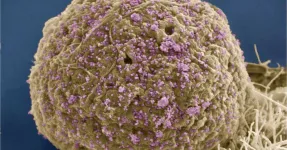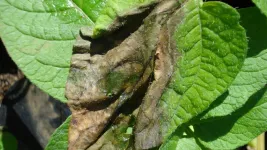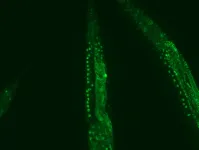(Press-News.org) A North Carolina State University-led study found it is possible to retrieve forensically relevant information from human DNA in household dust. After sampling indoor dust from 13 households, the researchers were able to detect DNA from household residents over 90% of the time, and DNA from non-occupants 50% of the time. The work could be a way to help investigators find leads in difficult cases.
Specifically, the researchers were able to obtain single nucleotide polymorphisms, or SNPs, from the dust samples. SNPs are sites within the genome that vary between individuals – corresponding to characteristics like eye color– that can give investigators a “snapshot” of the person.
“SNPs are just single sites in the genome that can provide forensically useful information on identity, ancestry and physical characteristics – it’s the same information used by places like Ancestry.com – that can be done with tests that are widely available,” says Kelly Meiklejohn, assistant professor of forensic science and coordinator of the forensic sciences cluster at NC State. Meiklejohn is corresponding author of the study.
“Because they’re single sites, they’re easier to recover for highly degraded samples where we may only be able to amplify short regions of the DNA,” Meiklejohn says. “Traditional DNA analysis in forensics amplifies regions ranging from 100 to 500 base pairs, so for a highly degraded sample the large regions often drop out. SNPs as a whole don’t provide the same level of discrimination as traditional forensic DNA testing, but they could be a starting place in cases without leads.”
Meiklejohn and her team recruited 13 diverse households and took cheek swabs from each occupant along with dust samples from five areas within each home: the top of the refrigerator; inside the bedroom closet; the top frame of the front door; a bookshelf or photo frame in the living room; and a windowsill in the living room.
Utilizing massively parallel sequencing, or MPS, the team was able to quickly sequence multiple samples and target the SNPs of interest. They found that 93% of known household occupants were detected in at least one dust sample from each household. They also saw DNA from non-occupants in over half of the samples collected from each site.
“This data wouldn’t be used like traditional forensic DNA evidence – to link a single individual to a crime – but it could be useful for establishing clues about the ancestry and physical characteristics of individuals at a scene and possibly give investigators leads in cases where there may not be much to go on,” Meiklejohn says. “But while we know it is possible to detect occupants versus non-occupants, we don’t know how long an individual has to stay in a household before they leave DNA traces in household dust.”
The researchers plan to address the question of how much time it takes for non-occupants to be detected in dust in future studies. Meiklejohn sees the work as being useful in numerous potential investigative scenarios.
“When perpetrators clean crime scenes, dust isn’t something they usually think of,” Meiklejohn says. “This study is our first step into this realm. We could see this being applied to scenarios such as trying to confirm individuals who might have been in a space but left no trace blood, saliva or hair. Also for cases with no leads, no hit on the national DNA database, could household dust provide leads?”
The work appears in the Journal of Forensic Sciences and was supported by funding from the NC State College of Veterinary Medicine. NC State Senior Vice Provost for University Interdisciplinary Programs Rob Dunn, NC State research associates Melissa Scheible and Laura Boggs, and Darrell Ricke of the Massachusetts Institute of Technology’s Lincoln Labs also contributed to the work.
-peake-
Note to editors: An abstract follows.
Using FastID to analyze complex SNP mixtures from indoor dust
DOI: 10.1111/1556-4029.15246
Authors: Kelly Meiklejohn, Melissa Scheible, Laura Boggs, Robert Dunn, North Carolina State University; Darrell Ricke, Massachusetts Institute of Technology
Published: Apr. 3, 2023 in the Journal of Forensic Sciences
Abstract:
Forensically relevant single nucleotide polymorphisms (SNPs) can provide valuable supplemental information to short tandem repeats (STRs) for investigative leads, and genotyping can now be streamlined using massively parallel sequencing (MPS). Dust is an attractive evidence source as it accumulates on undisturbed surfaces, often is overlooked by perpetrators, and contains sufficient human DNA for analysis. To assess whether SNPs genotyped from indoor dust using MPS could be used to detect known household occupants, 13 households were recruited and provided buccal samples from each occupant and dust from five predefined indoor locations. Thermo Fisher Scientific Precision ID Identity and Ancestry Panels were utilized for SNP genotyping and sequencing was completed using Illumina chemistry. FastID, a software developed to permit mixture analysis and identity searching, was used to assess whether known occupants could be detected from associated household dust samples. A modified “subtraction” method was also used in FastID to estimate the percentage of alleles in each dust sample contributed by known and unknown occupants. On average, 72% of autosomal SNPs were recovered from dust samples. When using FastID, a) 93% of known occupants were detected in at least one indoor dust sample and could not be excluded as contributors to the mixture, and b) non-contributor alleles were detected in 54% of dust samples (29 ± 11 alleles per dust sample). Overall, this study highlights the potential of analyzing human DNA present in indoor dust to detect known household occupants, which could be valuable for investigative leads.
END
The National Institute of Allergy and Infectious Diseases (NIAID), part of the National Institutes of Health, has awarded a five-year, $15.45 million grant to the San Diego Center for AIDS Research (SD CFAR) at UC San Diego, renewing support that extends back to an original establishing grant in 1994 at the height of the AIDS epidemic.
"The grant renewal represents NIAID's continued and enduring investment in our mission to be a critical regional resource in HIV research and education, to advance the discovery and development of ...
Statin therapy does not exacerbate muscle injury, pain or fatigue in people engaging in moderate-intensity exercise, such as walking, according to a study published today in the Journal of the American College of Cardiology. The findings are reassuring for people who experience muscle pain or fatigue from statins but need to engage in physical activity to keep their cholesterol levels low and their hearts healthy.
Statins have long been the gold standard for lowering LDL or “bad” cholesterol ...
A new online tool – the first of its kind for plant pathogens – will help researchers across the globe identify, detect and monitor species of Phytophthora, which have been responsible for plant diseases ranging from the devastating 1840s Irish potato famine to sudden oak death that still plagues West Coast oak population.
The new pathogen “tree of life” provides a plethora of information about each of the more than 192 formally described species – including their evolutionary history and relationships within groups – as well as more than 30 other informally described taxa. It also includes ...
Alexandria, VA – A symposium to kick off the year-long celebration of the 75th Anniversary of the National Institute of Dental and Craniofacial Research (NIDCR) was featured at the 52nd Annual Meeting & Exhibition of the AADOCR, held in conjunction with the 47th Annual Meeting of the CADR. The AADOCR/CADR Annual Meeting & Exhibition took place at the Oregon Convention Center in Portland on March 15-18, 2023.
The symposium explored a brief history of the founding of NIDCR and its early activities, followed by reflections of the former directors, Harold C. Slavkin, Lawrence A. Tabak and Martha ...
Alexandria, VA – The American Association for Dental, Oral, and Craniofacial Research (AADOCR) has announced the winners of the 2023 AADOCR Hatton Competition. The winners were recognized during the Opening Ceremonies of the 52nd Annual Meeting of the AADOCR, which was held in conjunction with the 47th Annual Meeting of the Canadian Association for Dental Research (CADR), that took place on March 15, 2023.
The Hatton Award was first presented as the "Novice Award" in 1953 and is the oldest IADR/AADOCR ...
Alexandria, VA – The American Association for Dental, Oral, and Craniofacial Research (AADOCR) has announced the winners of the 2023 AADOCR/CADR Joseph Lister Award for New Investigators. The winners were recognized during the Opening Ceremonies of the 52nd Annual Meeting of the AADOCR, which was held in conjunction with the 47th Annual Meeting of the Canadian Association for Dental Research (CADR), that took place on March 15, 2023.
First given in 2018, the AADOCR/CADR Joseph Lister Award for New Investigators is managed by AADOCR and supported by Johnson & Johnson Consumer, Inc. It was created to award young investigators ...
Alexandria, VA – The American Association for Dental, Oral, and Craniofacial Research (AADOCR) has announced the winners of the 2023 Student Competition for Advancing Dental Research Application (SCADA). The winners were recognized during the Opening Ceremonies of the 52nd Annual Meeting of the AADOCR, which was held in conjunction with the 47th Annual Meeting of the Canadian Association for Dental Research (CADR), that took place on March 15, 2023.
In 2017, AADOCR and Dentsply Sirona joined forces to co-sponsor SCADA, which was previously known as the Student Clinicians of ...
Wearable devices such as smart watches could be used to detect a higher risk of developing heart failure and irregular heart rhythms in later life, suggests a new study led by UCL researchers.
The peer-reviewed study, published in The European Heart Journal – Digital Health, looked at data from 83,000 people who had undergone a 15-second electrocardiogram (ECG) comparable to the kind carried out using smart watches and phone devices.
The researchers identified ECG recordings containing extra heart beats which are usually benign but, if they occur frequently, are linked to conditions such as heart failure and arrhythmia ...
Cold activates a cellular cleansing mechanism that breaks down harmful protein aggregations responsible for various diseases associated with aging. In recent years, studies on different model organisms have already shown that life expectancy increases significantly when body temperature is lowered. However, precisely how this works has still been unclear in many areas. A research team at the University of Cologne’s CECAD Cluster of Excellence in Aging Research has now unlocked one responsible mechanism. The study ‘Cold ...
A very subtle and seemingly random type of eye movement called ocular drift can be influenced by prior knowledge of the expected visual target, suggesting a surprising level of cognitive control over the eyes, according to a study led by Weill Cornell Medicine neuroscientists.
The discovery, described Apr. 3 in Current Biology, adds to the scientific understanding of how vision—far from being a mere absorption of incoming signals from the retina—is controlled and directed by cognitive processes.
“These ...


